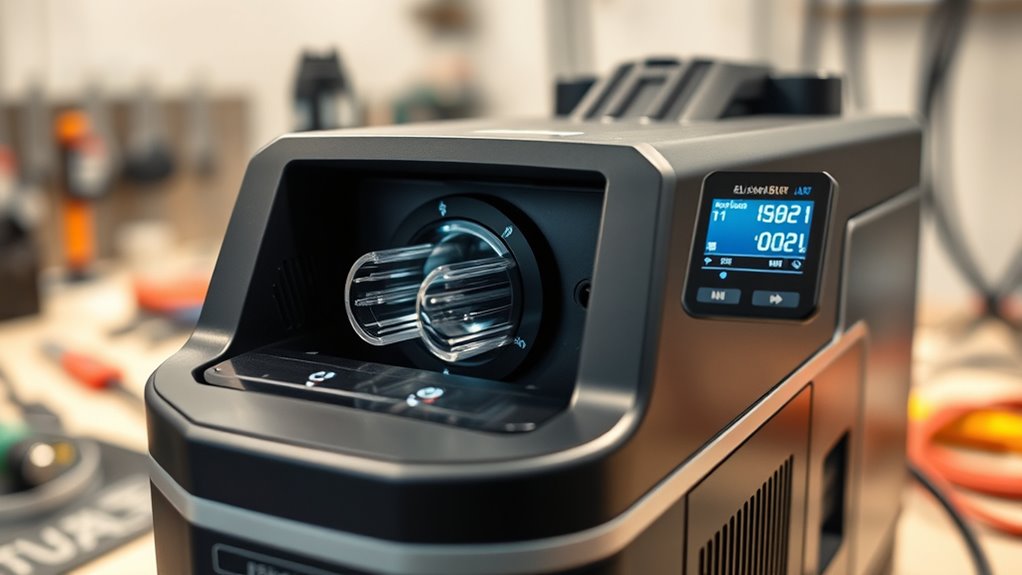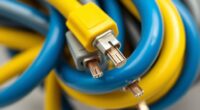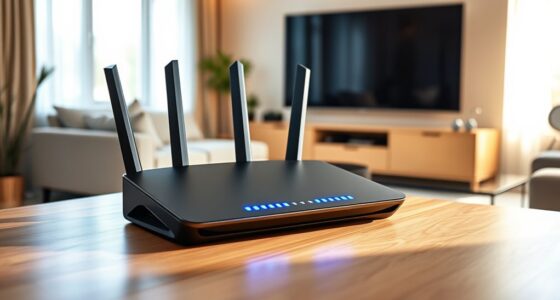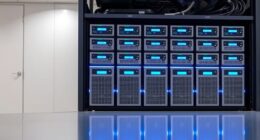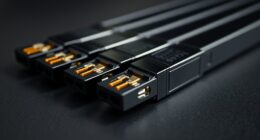If you’re seeking the top fiber fusion splicers of 2025, I recommend looking at models that offer high speed, precision, and durability, like the Ai-9, AI-20, and the 6481B Series. These splicers support various fiber types, have intuitive touch screens, and deliver low-loss, reliable connections even in tough environments. With options that emphasize portability and high performance, you’ll find the right tool for demanding fieldwork. Keep exploring to discover which one best fits your needs.
Key Takeaways
- Top splicers feature ultra-fast cycle times (5-8 seconds) for high productivity in demanding environments.
- Advanced core alignment and low-loss fusion technology ensure maximum connection quality and minimal re-splicing.
- Models offer rugged, portable designs with long-lasting batteries suitable for outdoor and fieldwork applications.
- User-friendly interfaces with touchscreens, preset modes, and app control streamline operation and setup.
- Compatibility with various fiber types, including specialty and microcables, makes these splicers versatile for diverse projects.
SM&MM Optical Fiber Fusion Splicer & Cleaver Kit (Ai-9)

If you’re looking for a versatile and budget-friendly fusion splicer, the SM&MM Optical Fiber Fusion Splicer & Cleaver Kit (Ai-9) is an excellent choice. It supports a wide range of fiber types, including SM, MM, bare fibers, pigtails, and multi-fiber cables, with compatible cladding and coating diameters. The device uses core alignment technology for minimal splice loss, and its high-resolution 5-inch screen makes adjustments easy. With features like a built-in power meter, fault locator, and quick splice and heat times, it offers reliable performance. Plus, its durable design and free replacement policy make it a cost-effective tool for professionals and hobbyists alike.
Best For: professionals and hobbyists seeking a versatile, budget-friendly fusion splicer capable of handling various fiber types and sizes with reliable performance.
Pros:
- Supports a wide range of fiber types including SM, MM, bare fiber, pigtails, and multi-fiber cables with compatible diameters.
- Features core alignment technology and a high-resolution 5-inch screen for precise, easy adjustments.
- Includes built-in power meter, fault locator, and quick splice and heat times, offering comprehensive functionality at an affordable price.
Cons:
- Automatic splice recognition may struggle with bad cleaves, requiring manual checks.
- Some users report fiber breakage during heat-shrink application and occasional charging or calibration issues.
- The small alcohol dispenser and stool may be inconvenient for extended use or larger workspaces.
SM&MM Automatic Optical Fiber Fusion Splicer & Cleaver Kit (AI-20)
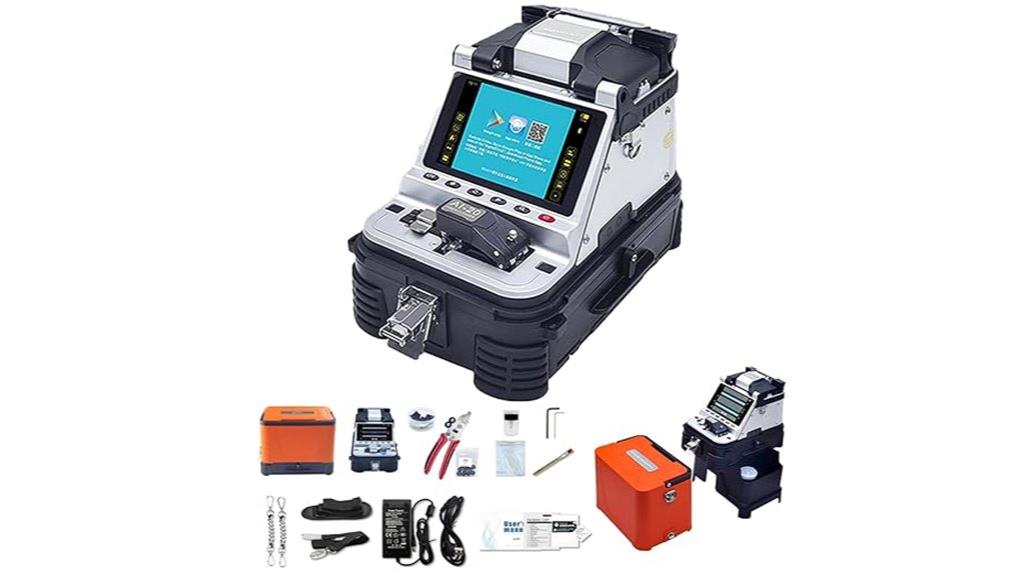
The SM&MM Automatic Optical Fiber Fusion Splicer & Cleaver Kit (AI-20) stands out as an excellent choice for professionals seeking a versatile, cost-effective splicer for low to moderate fiber installation projects. Its 3-in-1 fiber holder supports SM, MM, bare fiber, pigtails, and multi-fiber cables, accommodating various diameters and coating thicknesses. With a splice loss of just 0.025dB for SM and 0.01dB for MM, it delivers high-quality results. The device’s intuitive app control, high-resolution screen, and quick operation make it user-friendly. Designed for durability, it’s ideal for fiber-to-home work but not suited for mainline splicing.
Best For: low to moderate fiber splicing professionals seeking an affordable, versatile, and easy-to-use fusion splicer for fiber-to-home installations.
Pros:
- High splice quality with low loss (0.025dB for SM, 0.01dB for MM)
- User-friendly with app control and a high-resolution 5-inch screen
- Durable build with a long lifespan supporting up to 50,000 splices
Cons:
- Not suitable for mainline or connector-based splicing tasks
- Connectivity issues and charging problems reported by some users
- Limited to low to moderate splicing needs, not for high-volume or industrial applications
Fiber Optic Fusion Splicer with Touch Screen (6481B Series)

Designed for high-volume, demanding fieldwork, the Fiber Optic Fusion Splicer with Touch Screen (6481B Series) stands out with its rapid 7-second splicing and 18-second heating times, ensuring efficiency even during back-to-back operations. Its four high-precision motors enable ultra-low splicing loss of 0.02dB and support 5mm fusion for ultra-short cleaves. The 4.3-inch touch screen offers an intuitive graphical interface, while its all-in-one fixture accommodates various fiber types. Built tough, it withstands harsh environments and includes a long-lasting 6800mAh battery, capable of over 2,000 cycles. Reliable and user-friendly, it’s ideal for high-volume, precision fiber splicing in the field.
Best For: high-volume field technicians and professionals requiring fast, reliable, and durable fiber splicing solutions for demanding outdoor and industrial environments.
Pros:
- Rapid splicing and heating times (7 seconds and 18 seconds respectively) increase productivity.
- Ultra-low splice loss of 0.02dB ensures high-quality connections.
- Robust design with water, dust, shock, and temperature resistance suitable for tough field conditions.
Cons:
- Slightly heavier and larger compared to handheld models, which may impact portability.
- Limited to single-mode fiber splicing; may require additional accessories for other fiber types.
- The advanced features and durability come at a higher cost compared to basic models.
KOMSHINE Fiber Fusion Splicer FX39 with 6 Motors
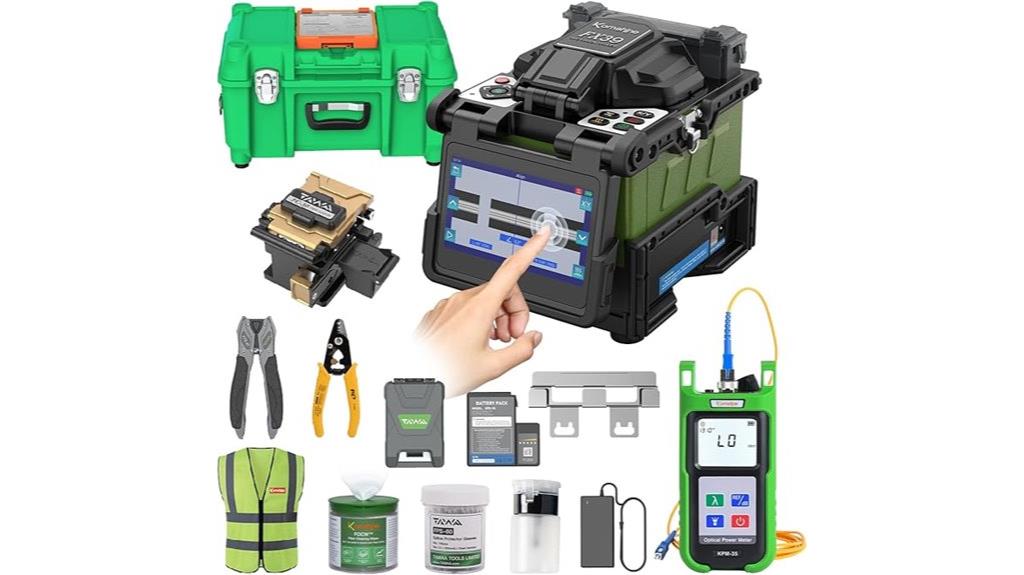
For technicians seeking a portable yet highly precise fusion splicer, the KOMSHINE FX39 stands out with its six-motor core alignment technology, ensuring peak fiber positioning even in challenging field conditions. Weighing just 2.25kg with a robust battery, it offers fast splicing (6 seconds) and heating (16 seconds). Its 4.3-inch color LCD touch screen simplifies operation, while the device’s support for multiple fiber types and a 3-in-1 fiber holder adds versatility. With an average splice loss of 0.01dB and electrode life of 4000 cycles, it delivers reliable, high-quality results. Designed for high-volume field work, the FX39 combines portability, durability, and precision effortlessly.
Best For: field technicians and professionals performing high-volume fiber optic splicing in diverse and challenging environments who need a portable, reliable, and precise fusion splicer.
Pros:
- Fast splicing and heating times (6s and 16s) for efficient workflow
- Six-motor core alignment technology ensures high-precision fiber positioning even in tough conditions
- Supports multiple fiber types with a 3-in-1 fiber holder, enhancing versatility
Cons:
- Limited to single fiber splicing, not suitable for ribbon fiber applications
- Electrode recalibration needed after approximately 1000-5000 splices, which may require maintenance
- Slightly bulky size may be less convenient for very tight or compact workspace setups
Signal Fire AI-9 Fusion Splicer for Fiber Optical Welding and Splicing

If you’re seeking a fusion splicer that combines speed and precision, the Signal Fire AI-9 is an excellent choice, especially for those handling small to medium fiber optic projects. It features a rapid 5-second splice time and a 15-second heating cycle, with up to 260 operations continuously. The device boasts a high-resolution 5-inch LCD with magnification up to 300x, ensuring accurate alignment. Its built-in power meter and VFL enable precise loss measurement and transmission verification. With a compact design, adjustable settings, and a battery life of over 3 hours, the AI-9 delivers reliable, high-quality splices, making it ideal for professional and DIY use.
Best For: DIY enthusiasts and small to medium professional fiber optic technicians seeking a fast, reliable, and user-friendly fusion splicer for various fiber types.
Pros:
- Rapid splice time of just 5 seconds with a 15-second heating cycle for efficient workflow
- High-resolution 5-inch LCD screen with up to 300x magnification for precise alignment
- Built-in power meter and VFL for accurate loss measurement and transmission verification
Cons:
- Requires regular maintenance and calibration to ensure optimal performance
- Bluetooth connectivity can be unstable, affecting remote monitoring and control
- Some users report issues with hot melt shrinking tubes potentially damaging fiber jackets
SM&MM Automatic Optical Fiber Fusion Splicer & Cleaver Kit (Ai-9)

The SM&MM Automatic Optical Fiber Fusion Splicer & Cleaver Kit (Ai-9) stands out as an excellent choice for technicians seeking a versatile, budget-friendly splicer that doesn’t compromise on performance. It features a 3-in-1 fiber holder compatible with SM, MM, bare fiber, and multi-fiber cables, supporting cladding diameters from 80-150μm. With core alignment technology, it delivers minimal splice loss—down to 0.01dB for MM fibers. The built-in power meter and visual fault locator enhance its utility, while the high-resolution screen makes operation straightforward. Durable and capable of over 50,000 splices, it offers a reliable, cost-effective solution for both professionals and backup setups.
Best For: technicians and fiber optic installers seeking a reliable, budget-friendly fusion splicer for both professional and backup use across SM, MM, and multi-fiber cables.
Pros:
- Supports a wide range of fiber types and diameters with versatile 3-in-1 fiber holder.
- Features core alignment technology for minimal splice loss and high-quality results.
- Built-in power meter and visual fault locator enhance functionality and troubleshooting.
Cons:
- Automatic splice recognition can struggle with bad cleaves, requiring manual checks.
- Some users experience fiber breakage during heat-shrink application or charging issues.
- Small accessories like the alcohol dispenser and stool may not suit all users’ preferences.
VEVOR Fiber Fusion Splicer with LCD Screen and 7800mAh Battery
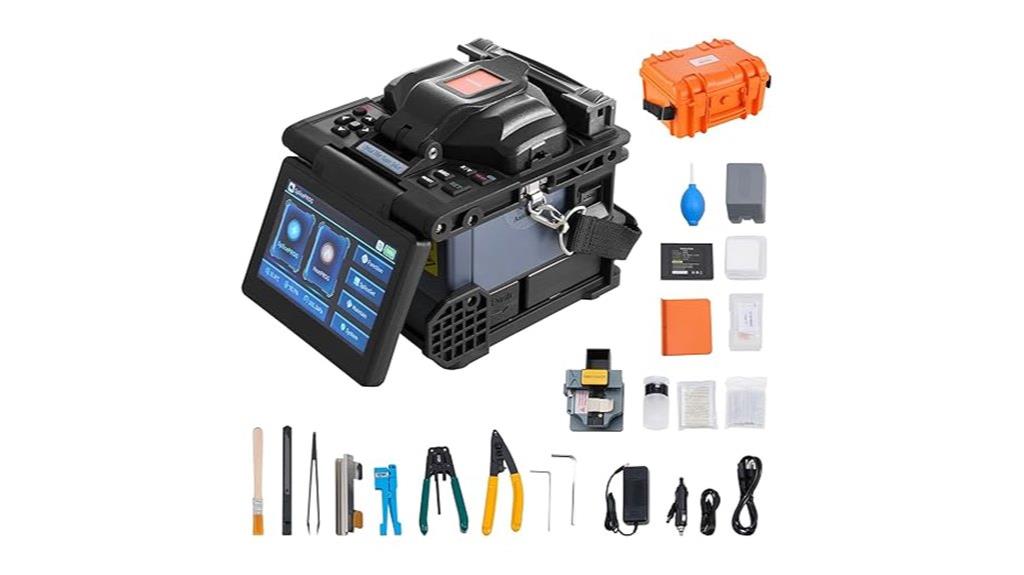
The VEVOR Fiber Fusion Splicer stands out with its powerful 7800mAh battery, making it an ideal choice for professionals working in the field. It delivers over 260 splicing and heating cycles per charge, ensuring reliable operation during long jobs. Its 5-inch HD LCD screen with multiple display modes and 1100x zoom provides clear visualization for precise fiber alignment. Equipped with six high-precision motors and core alignment technology, it achieves rapid splicing in just 6 seconds with minimal loss—0.01 dB for multimode fibers. Built from durable, lightweight materials, it’s designed to withstand harsh environments, making it perfect for demanding fieldwork.
Best For: Professionals and technicians who require reliable, high-precision fiber splicing in demanding outdoor environments with extended operational needs.
Pros:
- Long-lasting 7800mAh battery supports over 260 cycles, ideal for extended fieldwork
- High-precision core alignment technology enables rapid splicing with minimal loss of 0.01 dB
- Durable, lightweight design withstands harsh conditions such as dust, shock, and extreme temperatures
Cons:
- The device may be relatively expensive compared to basic fiber splicers
- Requires familiarity with advanced display features for optimal use
- Additional accessories and tools are needed for a complete work setup, which may increase overall cost
Fusion Splicer AI-5A Fiber Optical Fusion Splicer

Designed for professionals demanding high precision in challenging environments, the Fusion Splicer AI-5A stands out with its core alignment technology and rapid splicing capabilities. Its compact, lightweight design, paired with a small toolbox, makes it easy to transport and operate in diverse settings. Equipped with four motors, it supports long-distance fiber welding and performs reliably in extreme conditions like high altitudes, deserts, or cold climates. Splicing takes just 8 seconds, with heating in 18 seconds, and a 320x magnification ensures detailed quality checks. Its high-capacity battery delivers around 160 cycles per charge, perfect for extended fieldwork.
Best For: professionals requiring high-precision fiber splicing in challenging environments such as remote fieldwork, harsh climates, or long-distance installations.
Pros:
- High accuracy with core alignment technology and micrometer-level measurement, reducing splicing loss.
- Fast splicing and heating times (8 and 18 seconds respectively), increasing efficiency.
- Long battery life supporting approximately 160 cycles per charge for extended field use.
Cons:
- May require training to fully utilize advanced features like app connectivity and parameter settings.
- Slightly heavier than basic models due to its robust construction and multiple motors.
- Limited to 10 languages, which might not cover all user preferences globally.
Komshine FX39 Fusion Splicer Fiber Optical Core Alignment Splicer

If you’re looking for a fusion splicer that delivers rapid, high-precision fiber optic connections, the Komshine FX39 is an excellent choice. It offers 6-second splicing and 16-second heating, making it highly efficient for busy fieldwork. Equipped with core alignment technology and six motors, it guarantees precise results across various fiber types like SM, MM, and pigtails, compatible with multiple standards. Its 4.3-inch LCD display makes operation straightforward. With a splice loss of just 0.01dB and a large 7800mAh battery supporting around 400 cycles per charge, this device combines speed, accuracy, and portability for fiber optic projects.
Best For: technicians and field engineers requiring rapid, high-precision fiber optic splicing for diverse fiber types and standards.
Pros:
- Fast splicing and heating times (6s splicing, 16s heating) for increased efficiency.
- High accuracy with a splice loss of just 0.01dB and core alignment technology.
- Long battery life supporting approximately 400 cycles per charge, ideal for extended field use.
Cons:
- Slightly heavy weight with the battery (2.25kg), which may affect portability during long field operations.
- Accessories such as electrodes and fiber holders may need to be purchased separately or shipped randomly.
- Requires technical support for new users, which may involve additional setup time.
KOMSHINE Fiber Fusion Splicer FX39 with 6 Motors

For professionals seeking a reliable, portable fusion splicer that delivers precise results in the field, the KOMSHINE FX39 stands out thanks to its six-motor core alignment technology. This device is perfect for multi-FTTH projects, offering quick splicing in just 6 seconds and 16 seconds for heating. Its 4.3-inch color LCD touchscreen makes operation straightforward, while the 7800mAh battery supports up to 400 splicing and heating cycles. Weighing around 2.25kg, it’s designed for field use, tolerates imperfect cleaves, and supports various fiber types. Its durability, ease of maintenance, and high-precision alignment make it a top choice for professionals demanding efficiency and reliability.
Best For: field technicians and telecom professionals seeking a portable, reliable fusion splicer for multi-FTTH projects with high precision and quick splicing times.
Pros:
- Six-motor core alignment technology ensures high-precision splicing with minimal loss.
- Fast splicing (6 seconds) and heating (16 seconds) optimize field efficiency.
- Durable and lightweight design (around 2.25kg) suited for outdoor use and rough environments.
Cons:
- Cannot splice ribbon fibers or handle ribbon fiber burning attachments.
- Electrode maintenance required after approximately 1000-5000 splices, which may increase downtime.
- Slightly bulky size might be less convenient for some users in tight or confined spaces.
Komshine FX39 Fusion Splicer Fiber Optical with Touch Screen and Large Battery

The Komshine FX39 Fusion Splicer stands out with its rapid 6-second splicing and 16-second heating times, making it an ideal choice for professionals who need efficient and reliable fiber optic connections in the field. Its core alignment technology, combined with six motors, guarantees high precision across various fiber types like SM, MM, pigtails, and multi-cable fibers. The 4.3-inch color touch screen simplifies operation, while the large 7800mAh battery provides around 400 cycles per charge, supporting extended fieldwork. Lightweight at 2.25kg with the battery, this splicer offers portability, durability, and versatility for demanding telecom projects.
Best For: Telecom technicians and field engineers requiring rapid, high-precision fiber splicing solutions for diverse fiber types and extensive fieldwork.
Pros:
- Fast splicing (6 seconds) and heating (16 seconds) increase work efficiency.
- Supports multiple fiber types and cable configurations, enhancing versatility.
- Large 7800mAh battery offers approximately 400 splicing and heating cycles per charge.
Cons:
- Heavier weight with battery (2.25kg), which may impact prolonged handheld use.
- Additional accessories like electrodes and power meters are sold separately, increasing overall cost.
- Requires technical knowledge for optimal operation and maintenance.
Fusion Splicer AI-6A Fiber Optical Fusion Splicer

The Fusion Splicer AI-6A stands out for its fully automatic operation and rapid splicing capabilities, making it an excellent choice for professionals working in challenging environments. Its six-motor design guarantees efficient long-distance fiber welding, even in harsh conditions like high altitudes, deserts, or extreme cold. With core alignment technology, it delivers higher accuracy and lower splicing loss, automatically identifying fibers and auto-focusing. The device can complete fusion in just 8 seconds and heating in 18 seconds, boosting productivity. Its compact, lightweight toolbox makes transport easy, while a high-capacity battery supports around 160 cycles, ensuring dependable performance wherever you are.
Best For: professionals and technicians performing long-distance fiber optic splicing in harsh environments such as high altitudes, deserts, and cold regions who require high precision and rapid operation.
Pros:
- Fully automatic operation with core alignment technology for high accuracy and reduced splicing loss
- Rapid fusion and heating times (8 seconds and 18 seconds respectively) to boost productivity
- Compact, lightweight design with a high-capacity battery supporting approximately 160 cycles
Cons:
- May require familiarity with advanced features and mobile app integration for optimal use
- Limited to fiber optic splicing; not suitable for other types of cable work
- Potential high initial cost compared to manual splicing tools
VEVOR Fiber Fusion Splicer with Touch Screen and 7800mAh Battery
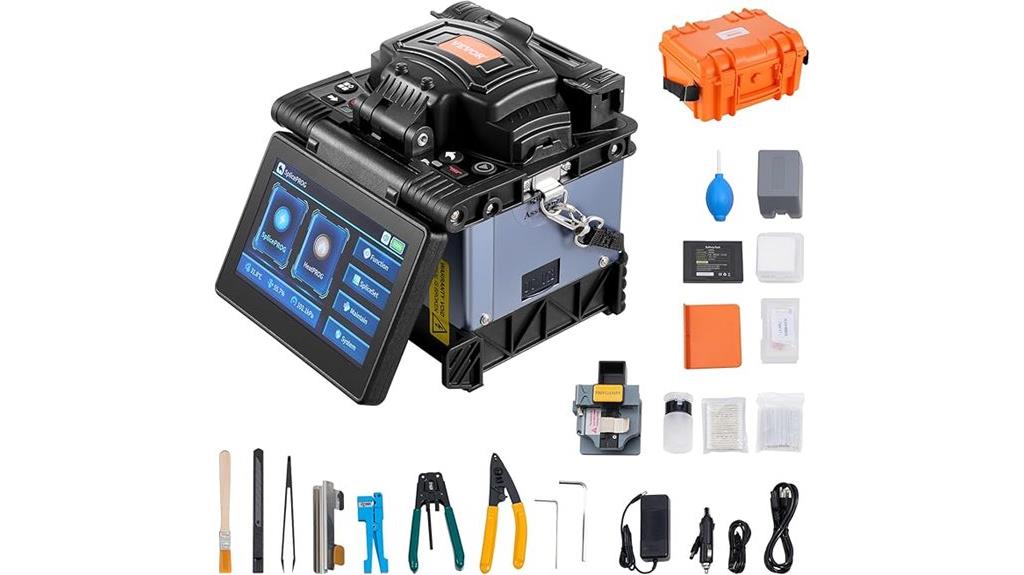
If you’re seeking a reliable fiber fusion splicer that combines advanced features with portability, the VEVOR Fiber Fusion Splicer stands out. It features high-precision 6 motors for rapid splicing in just 6 seconds and quick heating in 13 seconds, with fusion loss as low as 0.01 dB for MM fibers. Its 5-inch HD touch screen offers multiple viewing modes, including a 1100x zoom. The 7800mAh battery supports over 260 cycles, ensuring extended field use, while its sturdy construction withstands harsh environments. Plus, the complete kit includes essential tools, making this splicer a versatile, durable, and efficient choice.
Best For: technicians and field workers who require a portable, high-precision fiber splicer capable of handling diverse fiber types in harsh environments.
Pros:
- Rapid splicing and heating times (6 seconds for splicing, 13 seconds for heating) for increased efficiency.
- Low fusion loss of 0.01 dB for MM fibers ensures high-quality connections.
- Long-lasting 7800mAh battery supports over 260 cycles, ideal for extended field operations.
Cons:
- The device may be relatively expensive compared to basic splicing tools.
- The complexity of features might require a learning curve for new users.
- Limited to fiber splicing, not suitable for other types of cable or fiber repair tasks.
VEVOR Fiber Fusion Splicer with LCD Screen and 7800mAh Battery

For professionals seeking dependable, high-performance fiber splicing in the field, the VEVOR Fiber Fusion Splicer stands out with its impressive 7800mAh battery that supports over 260 continuous cycles. It features six high-precision motors with core alignment technology, allowing rapid splicing in just six seconds and quick heating in 13 seconds. The 5-inch HD LCD screen offers multiple display modes, including independent magnification and double-click zoom for precise fiber core visualization. Its durable, lightweight design withstands harsh environments, while the extensive kit ensures all tools are readily available. Overall, this splicer combines speed, accuracy, and reliability—making it an excellent choice for demanding fieldwork.
Best For: professionals and technicians requiring fast, precise, and reliable fiber splicing in the field under various harsh conditions.
Pros:
- Rapid splicing and heating times with core alignment technology for high efficiency.
- Extended 7800mAh battery supports over 260 continuous cycles, ideal for long fieldwork.
- Durable, lightweight design with a comprehensive tool kit for versatile and organized use.
Cons:
- The advanced features and kit may come at a higher price point compared to basic models.
- Requires familiarity with fiber splicing procedures and technology for optimal use.
- The size and weight, while portable, may still be cumbersome for extremely tight or remote spaces.
Fiber Optic Fusion Splicer with Touch Screen (6481B Series)

Designed for high-volume, demanding fieldwork, the Fiber Optic Fusion Splicer with Touch Screen (6481B Series) stands out thanks to its rapid splicing and heating capabilities, making it ideal for professionals who need efficiency and reliability. It features four high-precision motors, enabling 7-second splicing and 18-second heating. Its ultra-low splicing loss of 0.02dB ensures precise results, supporting ultra-short cleaves. The intuitive 4.3-inch touch screen simplifies operation, while its durable, lightweight design withstands harsh conditions. With a large-capacity battery supporting over 1,400 splices, it’s perfect for extended field use, combining speed, accuracy, and ruggedness in one performance-driven package.
Best For: professionals conducting high-volume, demanding field fiber optic splicing who require fast, reliable, and durable equipment.
Pros:
- Rapid splicing and heating times (7 seconds and 18 seconds respectively) for high efficiency.
- Ultra-low splicing loss of 0.02dB ensures precise and high-quality joins.
- Durable, lightweight, and weather-resistant design suitable for harsh environments.
Cons:
- May be limited to single-mode fiber splicing; some users recommend specific connectors for compatibility.
- Larger capacity battery and accessories increase overall weight and size slightly.
- Advanced features and interface might require a learning curve for new users.
Factors to Consider When Choosing a Fiber Fusion Splicer
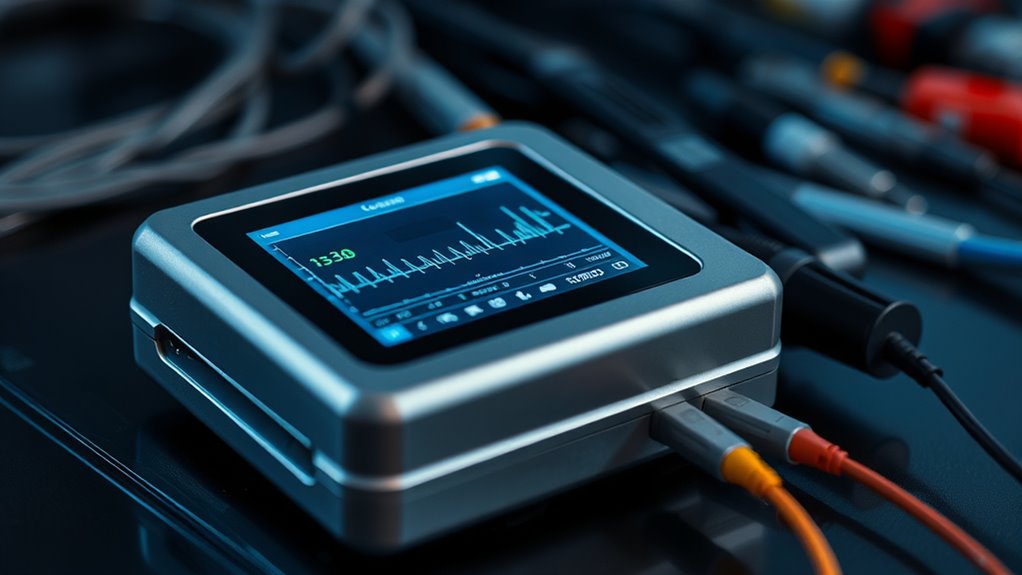
When choosing a fiber fusion splicer, I focus on key factors like compatibility with different fiber types and how quickly it can splice efficiently. I also consider how easy it is to operate, along with its durability and battery life for long-term use. These points help me select a splicer that meets my specific needs and guarantees reliable performance.
Compatibility With Fiber Types
Choosing a fiber fusion splicer that supports the specific fiber types you work with is vital for guaranteeing reliable and high-quality splices. Different fibers, like single-mode (G.652, G.657) or multi-mode (G.651), require compatible devices for maximum results. It’s also important to verify that the splicer accommodates the fiber cladding diameter range, typically 80-150μm, to guarantee proper alignment. Additionally, check if the device handles various cable constructions, such as pigtails, jumpers, or multi-fiber cables, for versatility. Support for different coating diameters (100-1000μm) is essential for matching fiber coatings and achieving precise cleaves. If your work involves specialized fibers like DS, NZDS, or EDF, guarantee the splicer can handle these less common types for extensive compatibility.
Splicing Speed and Efficiency
Faster splicing speeds can considerably boost productivity, especially in high-volume fiber optic projects where time is of the essence. Machines that splice in 6-8 seconds per splice streamline the workflow and reduce overall project timelines. Shorter heating cycles, around 15-20 seconds, enable quicker application of protective sleeves, saving valuable time during installation. High-efficiency splicers can perform over 1,000 to 2,000 splices on a single battery charge, minimizing downtime and increasing job site efficiency. Consistent splicing speeds ensure uniform quality, reducing errors caused by rushing or delays. For time-sensitive tasks like FTTH deployments or emergency repairs, advanced splicers with rapid cycle times are especially advantageous, helping technicians meet aggressive schedules without sacrificing precision. Speed and efficiency are key factors in selecting the right fusion splicer.
Ease of Operation
Ease of operation is a crucial factor because it directly impacts how quickly and accurately you can perform fiber splicing tasks. A user-friendly interface, such as a touchscreen or app control, makes setup and operation simpler, saving time. Automatic fiber recognition and alignment technology reduce manual adjustments, allowing even less experienced users to achieve precise splices easily. High-resolution displays with magnification up to 300x help me see the fiber core clearly without extensive technical knowledge. Intuitive controls and preset modes for different fiber types enable quick, efficient splicing with minimal training. Features like quick setup, minimal calibration, and straightforward maintenance further enhance usability, making the entire process smoother and more accessible, whether you’re a seasoned professional or just starting out.
Durability and Build Quality
Durability and build quality are vital when selecting a fiber fusion splicer, especially since field conditions can be tough and unpredictable. I look for devices built with high-quality materials like aircraft-grade aluminum or reinforced plastics, which resist impacts and harsh environments. An IP54 rating or higher is essential to protect against dust, water, and shocks during outdoor use. The chassis and internal parts should be shockproof and shock-absorbing, reducing the risk of damage from accidental drops. Sealed motor housings and protective covers help prevent dust and debris from entering, extending component life. A robust splicer should support over 50,000 splice cycles before needing replacement parts. Overall, a durable build ensures reliability and longevity, making it a smart investment for demanding field work.
Power Supply and Battery Life
When choosing a fiber fusion splicer, paying close attention to its power supply and battery life is crucial for reliable field performance. A high-capacity battery, typically between 5200mAh and 7800mAh, ensures you can complete multiple splicing and heating cycles without recharging. Battery life is usually measured by the number of splices and heat cycles per charge, with professional models supporting anywhere from 150 to over 400 cycles. Fast charging times, around 3 to 3.5 hours, help minimize downtime, especially in the field. Some splicers offer replaceable batteries, allowing for extended use without waiting to recharge. Additionally, power management indicators for remaining battery life and charging status are essential for maintaining continuous operation during critical tasks.
Precision and Loss Rates
Choosing a fiber fusion splicer with excellent precision is indispensable because even small differences in splice loss can considerably impact performance. Splice loss rates, measured in decibels (dB), are the key indicator of a splicer’s accuracy. Lower loss values, especially around 0.01 to 0.025 dB, are typically achieved with core alignment technology, which is preferable for high-quality splicing. Ultra-low splice losses of 0.02 dB or less are crucial for long-distance and high-speed data applications, ensuring minimal signal degradation. Additionally, a reliable splicer should handle ultra-short cleaves, around 5mm, without increasing loss. Consistent low-loss results across multiple fibers reflect the device’s stability and precision. Prioritizing these factors helps ensure the best performance and dependable network connections.
Additional Features and Tools
Additional features and tools substantially enhance a fiber fusion splicer’s overall performance and ease of use. Built-in power meters, visual fault locators, and app connectivity simplify troubleshooting and monitoring, making fieldwork more efficient. Including essential tools like fiber strippers, cleavers, and alcohol dispensers in the kit ensures precise fiber preparation and reduces setup time. Adjustable cleave lengths and multiple splice modes allow customization for different fiber types and project demands. Accessories such as spare electrodes, heat shrink tube applicators, and backup tools extend the device’s lifespan and support high-volume jobs. Large-capacity batteries and portable cases with organized compartments further boost operational convenience, especially in field conditions. These added features and tools help guarantee reliable splicing, reduce downtime, and improve overall productivity.
Price and Overall Value
Price and overall value are crucial factors to take into account because a higher upfront investment often brings better performance, durability, and long-term savings. While premium splicers typically feature advanced capabilities, they tend to cost more initially. However, their durability, lower splice loss, and longer electrode lifespan can reduce re-splicing and maintenance costs over time, improving overall value. Budget models might seem affordable upfront but often have higher operational costs due to shorter electrode life and limited support. To find the best fit, I compare price-to-performance ratios, ensuring that a less expensive splicer still meets my needs without sacrificing quality. Balancing initial cost with long-term benefits helps me select a device that offers reliability, efficiency, and cost-effectiveness over its lifespan.
Frequently Asked Questions
What Are the Maintenance Requirements for High-End Fusion Splicers?
High-end fusion splicers require regular maintenance to guarantee peak performance. I recommend cleaning the fiber holders and cleaver contacts weekly, calibrating the splicer after every few uses, and inspecting the electrodes for wear. Additionally, keep the lens clean with a soft cloth, replace consumables as needed, and store the device in a dry, dust-free environment. Proper maintenance extends the lifespan and guarantees precise, reliable splicing results.
How Do Splicer Models Compare in Handling Specialized Fiber Types?
Think of splicer models like skilled dancers, each with their own specialty. Some handle delicate, specialized fibers gracefully, like fine ballet dancers, while others excel in speed and robustness, like energetic tap dancers. I’ve found that high-end models often come with adjustable settings, making them versatile for various fibers. Choosing the right splicer is about matching its ‘dance style’ to the fiber type you’re working with, ensuring smooth, precise results every time.
What Safety Features Are Included in Modern Fusion Splicers?
Modern fusion splicers come equipped with essential safety features like automatic shut-off, fiber clamps that prevent accidental injury, and protective covers to guard against laser exposure. I always appreciate models with clear indicators and user-friendly interfaces that remind me of safety protocols. These features guarantee I work confidently and securely, minimizing risks while maintaining precision. Staying safe is just as important as getting a perfect splice, and today’s splicers deliver on both fronts.
Can Fusion Splicers Operate Effectively in Extreme Environmental Conditions?
Yes, modern fusion splicers are designed to operate effectively in extreme environmental conditions. I’ve found that many models feature robust insulation, sealed enclosures, and temperature compensation technology, allowing them to perform reliably in harsh environments like cold, heat, or humidity. These enhancements ensure precise splicing even in challenging conditions, giving me confidence that I can use them outdoors or in difficult settings without sacrificing quality.
What Are the Typical Training Needs for New Fusion Splicer Users?
Training for new fusion splicer users is surprisingly intensive, almost like mastering a high-stakes art form. I’ve found that it usually involves understanding fiber types, mastering precise cleaving, and learning to operate the delicate splicer controls. Expect hands-on practice, troubleshooting, and safety procedures. It’s a steep learning curve, but with patience and proper instruction, you’ll become confident, ensuring perfect splices every time and avoiding costly mistakes.
Conclusion
Choosing the right fiber fusion splicer really boosts your efficiency and precision. Did you know that high-quality splicers can reduce splice loss by up to 50%? That means fewer re-splices and better signal quality. Whether you’re a professional or hobbyist, investing in a reliable, feature-rich splicer makes all the difference. I hope my top picks help you find the perfect tool to elevate your fiber optic projects. Happy splicing!
